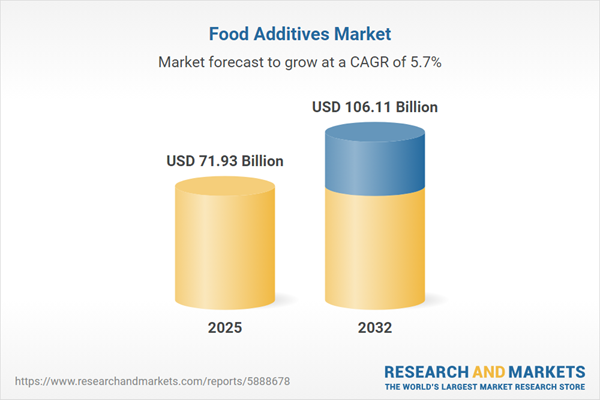Speak directly to the analyst to clarify any post sales queries you may have.
The food additives market is undergoing rapid transformation, with industry leaders facing heightened regulatory demands and rising consumer expectations that require agile, strategic responses. Senior decision-makers must align compliance with product innovation, ensuring their businesses remain responsive and competitive in a dynamic marketplace.
Market Snapshot: Food Additives Market Size & Growth
The global food additives market demonstrates steady expansion, propelled by advancements in ingredient technologies and tighter safety regulation. As of 2024, the sector reached a value of USD 68.12 billion, with projections indicating ongoing growth to USD 71.93 billion in 2025 and USD 106.11 billion by 2032, at a compound annual growth rate (CAGR) of 5.69%. This upward trajectory is built on consistent investment in research, optimization of supply chain management, and targeted product strategies among leading manufacturers. Decision-makers are focusing on integrating compliance measures within broader organizational priorities, simultaneously improving risk oversight and market positioning. The combination of technological capability and regulatory agility is shaping long-term growth opportunities within the food additives market.
Scope & Segmentation of the Global Food Additives Market
This analysis provides actionable segmentation, equipping leaders with the insights needed to effectively address risk and pursue new commercial opportunities across all market dimensions:
- Product Types: Antioxidants, colorants, emulsifiers, flavor enhancers, preservatives, stabilizers, sweeteners, and thickeners, each crucial for quality control, consumer satisfaction, and shelf-life improvement.
- Applications: Segments include bakery, confectionery, dairy, frozen desserts, beverages, poultry, culinary applications, and processed foods, supporting product quality and a strong presence in diverse markets.
- Functions: Encompasses flavor enrichment, nutritional enhancement, shelf-life extension, texture optimization, and visual appeal, with technological advancements in emulsification and gelling increasingly vital as consumer standards evolve.
- Sources: Covers both animal and plant-based origins such as fruits, herbs, vegetables, and microorganisms, illustrating the industry's focus on traceability and sustainable sourcing.
- Forms: Considers multiple manufacturing formats—granular, liquid, paste, and powder—providing flexibility to suit various operational and production needs.
- Regions: Examines market activity and regulatory impacts in the Americas, Europe, Middle East, Africa, and Asia-Pacific, noting regional distinctions that affect strategies for innovation and market entry.
- Key Companies: Highlights leaders including Archer-Daniels-Midland Company, Cargill Incorporated, Koninklijke DSM N.V., BASF SE, DuPont de Nemours Inc., International Flavors & Fragrances Inc., Kerry Group plc, Ingredion Incorporated, Tate & Lyle PLC, and Chr. Hansen Holding A/S, each with tailored investment and innovation approaches.
Key Takeaways for Decision-Makers
- Continued investment in product development enhances a manufacturer's capability to adapt to evolving regulations while strengthening competitive standing in an increasingly rigorous landscape.
- The shift toward clean-label and plant-based solutions promotes enhanced product transparency, increasing professional buyer trust and meeting shifting organizational and regulatory expectations.
- Digital traceability tools and precision fermentation are setting new standards for operational visibility and supply chain efficiency, supporting both compliance and organizational agility.
- Diversification of supply sources across multiple global regions improves risk management and strengthens adherence to region-specific regulatory frameworks, improving supply resilience.
- Partnerships with research organizations and industry groups accelerate the creation of advanced and customized additives, fostering innovation as new market and consumer trends emerge.
Tariff Impact: Strategic Responses to US Tariffs in 2025
The introduction of US tariffs on select imported food additives, notably colorants, emulsifiers, and flavor enhancers, necessitates a strategic review of sourcing and procurement. Leading organizations are expanding supplier networks throughout North and Latin America, prioritizing investments in domestic manufacturing, and leveraging biotechnological innovation in production. These strategies are designed to ensure ongoing supply chain reliability and facilitate regulatory alignment in jurisdictions impacted by new trade measures.
Methodology & Data Sources
This report synthesizes quantitative research, in-depth regulatory analysis, scientific literature review, and direct industry stakeholder feedback. The resulting insights guide leaders as they refine market strategies and manage risks in the evolving food additives sector.
Why This Food Additives Market Report Matters
- Delivers actionable, segment-specific intelligence to support resource allocation and inform long-term investment priorities for senior decision-makers.
- Provides frameworks to improve transparency and foster a robust, adaptable supply chain—key for ongoing compliance and risk mitigation in a volatile regulatory environment.
- Equips leaders to advance sustainability initiatives while navigating continual changes in industry policy and consumer preferences.
Conclusion
This report offers senior leadership the insight and structure needed to address regulatory complexities, drive targeted product development, and strengthen operational resilience across the global food additives market.
Additional Product Information:
- Purchase of this report includes 1 year online access with quarterly updates.
- This report can be updated on request. Please contact our Customer Experience team using the Ask a Question widget on our website.
Table of Contents
3. Executive Summary
4. Market Overview
7. Cumulative Impact of Artificial Intelligence 2025
Companies Mentioned
The companies profiled in this Food Additives market report include:- Archer-Daniels-Midland Company
- Cargill, Incorporated
- Koninklijke DSM N.V.
- BASF SE
- DuPont de Nemours, Inc.
- International Flavors & Fragrances Inc.
- Kerry Group PLC
- Ingredion Incorporated
- Tate & Lyle PLC
- Chr. Hansen Holding A/S
Table Information
| Report Attribute | Details |
|---|---|
| No. of Pages | 199 |
| Published | November 2025 |
| Forecast Period | 2025 - 2032 |
| Estimated Market Value ( USD | $ 71.93 Billion |
| Forecasted Market Value ( USD | $ 106.11 Billion |
| Compound Annual Growth Rate | 5.6% |
| Regions Covered | Global |
| No. of Companies Mentioned | 11 |









